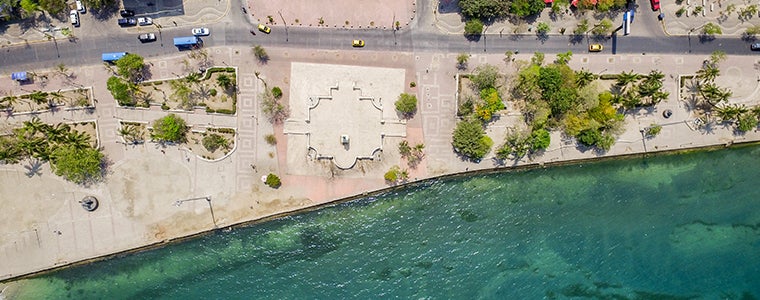Driven by declining global investment yields – to which Latin America has been no exception – institutional investors have been and will likely continue to increase their allocation to real assets – especially infrastructure. At the same time, investors are also increasingly looking for sustainable assets. As evidence grows on the benefits stemming from the integration of environmental, social and governance factors into investment decisions, they are realizing that sustainable assets can deliver better risk-adjusted returns. Sustainable investments can indeed improve investors’ ability to anticipate and reduce regulatory and financial risks, such those arising from the potential incoming financial regulations on climate-related risk exposure. They can also help improve the management of operational and reputational risks in complex projects – which can be significant as shown from a recent IDB study – and open new business opportunities.
In Latin America and the Caribbean (LAC), the demand for bankable sustainable assets is rising, and so is the potential supply from the planned pipeline of infrastructure assets. Investors’ interest emerges clearly from the oversubscribed issuance of Campo Palomas green bonds, an innovative B-Bond structure that refinanced an existing loan from the IDBG (multilateral loan) and syndicated with a commercial loan (from DNB Bank). On the supply side, the potential pipeline is in the order of several billion. Governments have been strengthening their efforts to attract private capital towards infrastructures by improving legislative frameworks and increasing the visibility of the project pipelines that will be seeking investments in the incoming years. For instance, Argentina expects to mobilize a total of US$ 26 billion by 2022 through a public-private investment program for roads, energy, water, and housing. In Brazil, the Investment Partnership Program (PPI) has qualified 145 projects for a total of US$ 40 billion of expected investments; and finally, BANOBRAS’ Proyectos Mexicos has mapped an investment opportunity of more than 300 projects among private concessions and PPPs for a total of US$ 177 billion.
But, how can investors identify and evaluate the sustainable investment opportunity in such pipelines? What are investors’ preferences and constraints to increase allocations in LAC?
The answer to these questions is crucial. We, as a Multilateral Development Bank, need to offer solutions capable of effectively attracting private capital towards infrastructure projects that are planned, developed and operated so that to deliver value over their long life-cycles. To this end, we put three main action items on our “to do” list:
1) Ensure market clarity on what qualifies as sustainable infrastructure.
Drawing from existing sustainability standards and principles, the IDB Group has developed a working definition of sustainable infrastructure to enhance governments and investors’ ability to discern what characterizes a sustainable infrastructure. To make this framework operational the IDB Group is working closely with governments and investors to integrate environmental, climate, social and governance factors in the planning, design, construction, and management of infrastructure projects.
From the governments’ perspective, it will be crucial to identify, signal and structure infrastructure projects as sustainable assets with consistent and transparent methodologies, designing the adequate incentives and requirements for the private sector to follow.
For investors, instead, this implies integrating sustainability in their core investment strategy, in the allocation of organizational resources, and the adoption of the tools required to manage such investments, evaluate their performance and disclose results to stakeholders.
2) Design adequate financial and non-financial solutions that match investors’ appetite, preference and risk tolerance.
The IDB Group already offers several risk mitigation instruments, blended finance, and co-financing solutions; it also offers non-financial support to governments, investors and project developers. Nevertheless, to ensure our financing and/or non-financing strategy and product proposition continues to effectively meet investors’ evolving needs, we launched in collaboration with Mercer a short survey to identify and assess investors’ appetite, preferences, risk tolerance and challenges when investing in infrastructure in LAC. It also aims to understand available resources and tools investors may use to integrate sustainability into their investment process. We invite investors, lenders and asset managers interested in infrastructure in LAC to complete this short survey. We will publish the aggregated results in Q2 2018.
3) Connect the investment opportunity with the region’s capital markets.
While sustainability certifications and labels, green bonds or dedicated funds can help investors to identify sustainable infrastructure investment opportunities, the investable universe is not yet easily identifiable, nor easily accessible. To help fill this gap, enhance the availability and “visibility” of sustainable infrastructure pipelines, and support regulatory frameworks conducive to sustainable investments, the IDB Group is convening investors, project developers, lenders and regulators in a series of dedicated roundtables across the region. Inaugurated last year in Rio de Janeiro, these roundtables represent an opportunity for enhancing awareness about the business case for sustainability and discuss regulatory changes and/or investment instruments that can facilitate greater private sector participation in infrastructure financing. The next meeting is planned for June 27th, 2018 in Argentina, while others will soon be coming in Colombia, Mexico, and Peru. If you would like to join these meetings, please write to us.


Leave a Reply